Mastering the Art and Science of Paper Airplanes
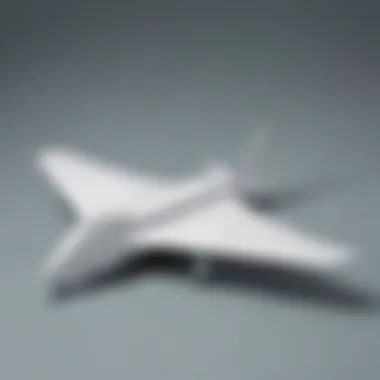
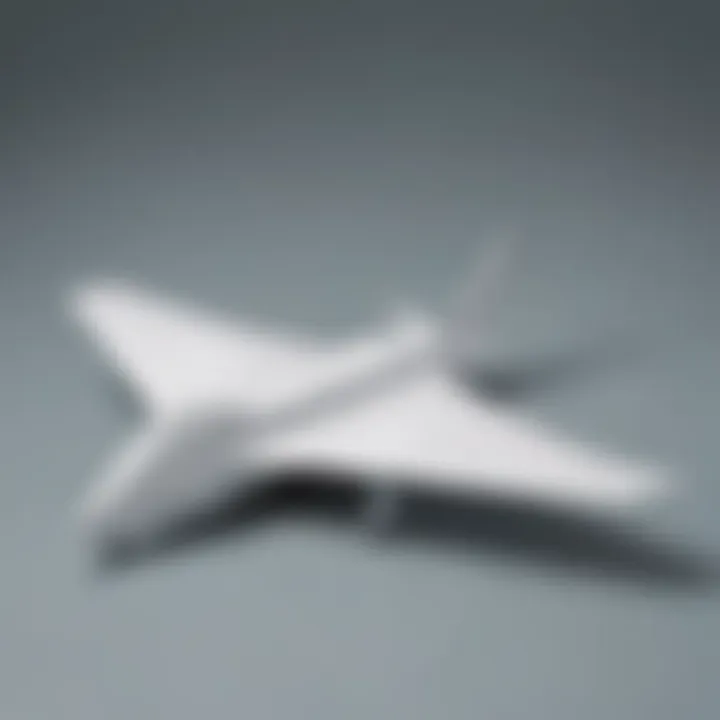
Intro
Paper airplanes are not just simple toys. They play a crucial role in helping us understand fundamental scientific concepts such as aerodynamics, lift, and gravity. This activity brings together art and science in a unique way. While creating different designs, one also experiments with various folding techniques. These aspects can spark curiosity in young minds and can lead to engaging discussions about how things fly.
Folding a paper airplane involves more than just a few simple steps. Each design offers opportunities to explore different scientific principles. For children, this can be an exciting way to learn by doing. The process can enhance creativity and critical thinking. Parents and guardians can also benefit from this activity, as it provides an excellent bonding experience while fostering educational growth.
In this article, we will cover:
- The basic principles of aerodynamics.
- Different folding techniques for paper airplanes.
- The significance of creativity in the folding process.
- Step-by-step guides for various airplane models.
By the end of this guide, readers will appreciate not only the fun involved but also the learning opportunities that come from folding paper airplanes.
Prologue to Paper Airplane Folding
Folding paper airplanes is not just a playful activity; it is a rich combination of art and science. The process of creating these flying models involves a careful balance of creativity and understanding of basic aerodynamics. As children fold and design their planes, they unknowingly engage in an educational experience that fosters both critical thinking and manual skills. This section will emphasize the significance of learning through paper airplane folding. It will show that this simple pastime can provide insights into physics and engineering.
What is a Paper Airplane?
A paper airplane is a model aircraft made from a single sheet of paper. It is crafted by folding the paper into specific shapes that mimic the structure of real airplanes. The key characteristics that define a paper airplane include its wings, body, and tail. Each design affects how the plane flies. For instance, a classic dart design tends to fly fast and straight. In contrast, a glider design can stay aloft longer due to its wider wingspan. Notably, even small changes in folding techniques can significantly impact flight performance. This activity not only promotes creativity but also highlights essential scientific principles that dictate flight dynamics.
Historical Perspective
The history of paper airplanes dates back centuries. Historical records suggest that the concept of folding paper for flight is not new. Early prototypes of paper airplanes appeared in various cultures, showcasing the enduring human curiosity about flight. Renowned figures, like Leonardo da Vinci, explored aerodynamics long before the first powered aircraft took to the skies. In the early 20th century, paper airplanes gained traction in educational settings as tools to demonstrate flight principles. Several competitive events, like the Red Bull Paper Wings competition, have elevated this simple activity into the realm of sport. Overall, the historical journey of paper airplanes reflects humanity’s ongoing fascination with flight and innovation.
The Science Behind Flight
The science of flight is fundamental to understanding how paper airplanes function. This subject provides insights into the behavior of planes in the air, relying heavily on the principles of aerodynamics. Understanding these principles enriches the experience of crafting paper airplanes, as it connects the act of folding with tangible scientific concepts. Mastering these concepts can guide enthusiasts to create better designs and achieve longer flight distances.
Basic Aerodynamics
Aerodynamics is the study of how air interacts with solid objects. In the context of paper airplanes, it involves four main forces: lift, drag, thrust, and weight. Each of these forces plays a role in determining the flight behavior of paper planes. Understanding them is indispensable for anyone who wishes to excel in paper airplane creation.
Lift
Lift is the force that enables an airplane to rise in the air. It occurs due to the difference in air pressure above and below the wings of the airplane. This principle is crucial for paper airplanes, as it determines how high and how long they can fly.
A key characteristic of lift is that it needs to be greater than the weight of the airplane for it to ascend. Paper airplanes usually achieve lift through careful wing design and by throwing them with enough force. A well-designed paper airplane can easily demonstrate lift, making it a popular choice in educational settings. Its unique feature lies in its necessity for proper wing shape and angle, which can lead to longer flight durations. However, if not designed appropriately, it may struggle to fly effectively.
Drag
Drag refers to the resistance an airplane faces as it moves through the air. This force works against thrust and is an essential aspect of flight dynamics. Understanding drag helps in refining paper airplane designs to minimize resistance and enhance performance.
A vital characteristic of drag is its dependency on the speed and shape of the airplane. For paper airplanes, reducing drag is beneficial as it can lead to increased flight distances. The unique feature of drag is its dual nature; while it can slow down an airplane, some drag is necessary for stability. Excessive drag can hinder performance, making it crucial to strike a balance in design.
Thrust
Thrust is the force that propels an airplane forward. In the case of paper airplanes, thrust is generated by the throw of the builder. This aspect is significant because it determines the initial speed and trajectory of the airplane.
A key characteristic of thrust is that it must overcome drag for effective flight. Proper technique in throwing the paper airplane can optimize thrust, allowing it to achieve maximum distance. The unique aspect of thrust is that it is entirely controlled by the practitioner, making it an important factor in the flight of a paper airplane. However, insufficient thrust can prevent a paper airplane from gaining lift and succeeding in flight.
Weight
Weight is the downward force due to gravity. In paper airplane flight, weight must be balanced with lift. This characteristic makes weight an important factor to consider when designing paper airplanes. If the weight is too heavy compared to lift, the plane will not ascend. Conversely, if it is too light, the airplane may not maintain stability in the air.
The unique feature of weight lies in its impact on the overall design and materials chosen for creating paper airplanes. Heavier materials may enhance durability but can make it challenging to achieve lift. Finding the appropriate weight is crucial for the successful flight of a paper airplane.
How Paper Airplanes Demonstrate Scientific Principles
Paper airplanes provide a hands-on way to understand complex scientific principles. They showcase how simple folding techniques can influence aerodynamics, making the learning process both enjoyable and effective.
Through experimentation with different designs, one can observe the influences of lift, drag, thrust, and weight in real time. This engagement fosters a deeper understanding of these concepts, making them accessible to learners of all ages.
The combination of art and science in paper airplane folding also sparks creativity, encouraging individuals to explore various designs and techniques.
Materials for Folding
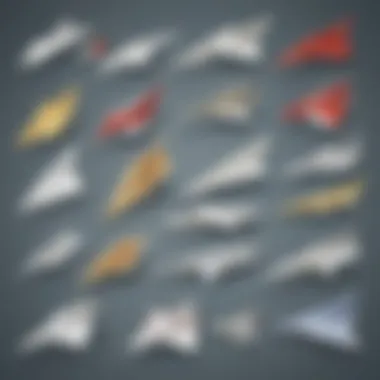
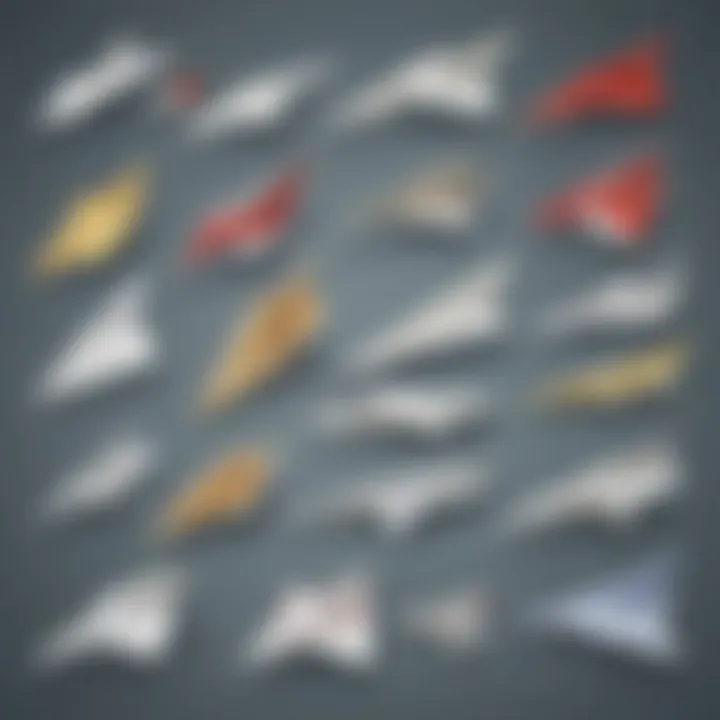
Selecting the right materials for paper airplane folding is critical for achieving the best flight performance. The type of paper used, along with additional tools, significantly impacts how the airplane flies and how enjoyable the process is. Using appropriate materials can lead to better aerodynamics, ease of folding, and the durability of the paper airplanes.
Understanding what materials work best encourages creativity and experimentation, promoting both learning and enjoyment.
Choosing the Right Paper
Weight and Thickness
Weight and thickness of paper are crucial factors to consider when folding paper airplanes. Lighter paper generally allows for longer flight distances due to reduced drag, while thicker paper often provides better structural integrity. The most common paper type used is printer paper, which typically weighs 20 lb (75 g/m²).
This choice is beneficial because it strikes a balance between too much weight and too little durability. However, very lightweight options, such as tissue paper, can crumple easily and may not hold their shapes under flight conditions. On the other hand, heavier card stocks can create looser folds, resulting in less effective flight patterns.
In summary, choosing paper with the right weight and thickness contributes to optimal performance in paper airplane design, offering a good mix of flight distance and durability.
Texture and Finish
The texture and finish of the paper also matter greatly in paper airplane folding. A smooth finish allows for easier folds and can enhance the glide of the airplane. Glossy papers, while visually appealing, can sometimes lead to inconsistent folds due to their stiffness.
Matte papers are often preferred because they provide more grip during folding, ensuring precise and neat creases, which are essential for aerodynamics. This choice can be beneficial, especially for beginners who might struggle with keeping their folds uniform.
Additional Tools and Supplies
Folding paper airplanes often requires some additional tools. These supplies can aid in the construction and decoration of paper airplanes. Having the right tools on hand makes the experience more enjoyable and efficient.
Scissors
Scissors can play a role in customizing paper airplanes, particularly when one wants to add elements that enhance performance or aesthetics. They allow you to trim edges and create unique shapes that can affect flight dynamics.
A sharp and reliable pair of scissors is crucial. They enable clean cuts, leading to more precise shapes. This simple tool can be popular among users who want to take their designs to the next level. However, they are not always necessary for basic folding techniques.
In short, scissors provide versatility and creativity, but care should be taken to use them safely, especially around younger children.
Tape or Glue
Tape or glue is another essential supply that aids in securing different parts of the airplane. Using tape or glue, you can attach wings or reinforce folds. This addition can enhance the sturdiness of the paper airplane, ensuring that it withstands multiple flights without coming apart.
While tape is quick and easy to use, glue may allow for a stronger bond. Both options filter into a choice of convenience versus permanence.
Utilizing tape or glue can introduce new design elements and variations that enhance learning and provide insight into structural design.
Markers and Decorations
Markers and decorations serve to personalize paper airplanes, making the activity engaging and creative. Children can use various colors to create unique designs, making the process not only about aerodynamics but also expressing personal style.
The artistic aspect can enhance the overall project. It can foster the development of fine motor skills as well. However, it is key to use lightweight decorations, as heavier items can affect flight performance adversely.
In summary, while markers and decorations contribute to creativity, keeping their weight in mind is essential for successful flight.
Basic Folding Techniques
Folding techniques are essential to mastering the art of paper airplane construction. They influence how an airplane performs during flight. Good folding methods create symmetry and balance, which are crucial for achieving longer distances and stable flight patterns.
Understanding basic folding techniques is an entry point to explore more advanced designs. When beginners grasp these techniques, they can experiment more freely and even develop their own designs. Simple folds lay the groundwork for intricate designs later. Moreover, mastering the foundational skills fosters confidence in young creators, encouraging them to explore the bounds of what their paper airplanes can do.
Step-by-Step Instructions for Simple Designs
Classic Dart
The Classic Dart is a staple in the paper airplane world. It is characterized by its narrow wings and pointed nose. This design is known for its speed and straight flight path, making it a popular choice for many. The Classic Dart’s sleek shape minimizes drag, allowing for impressive distances.
To fold a Classic Dart:
- Start with a standard sheet of paper.
- Fold the paper in half lengthwise, then unfold.
- Fold the top two corners to the center crease, forming a triangle.
- Fold the triangle down, making sure it aligns with the bottom of the previous folds.
- Finally, fold the sides down to create wings.
The main advantage of the Classic Dart is its performance. However, it is less forgiving with regards to folding precision. An imperfect fold can lead to very poor flight.
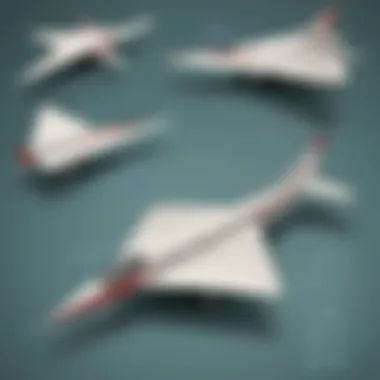
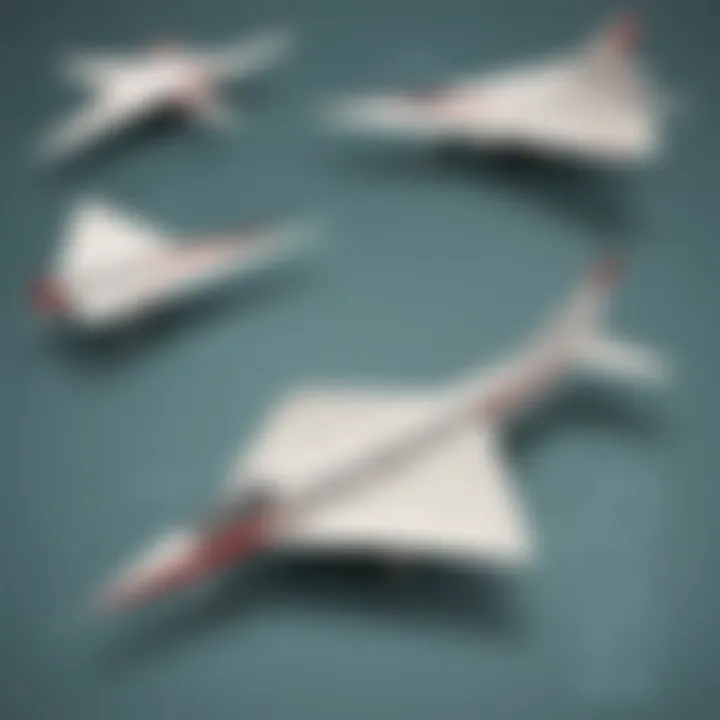
Glider
The Glider offers a wider wing span, contributing to its ability to float and cover long distances. This design is especially good for gentle, long flights. The Glider can carry a small weight, enhancing its flying capabilities.
To fold a Glider:
- Begin with a fresh sheet of paper.
- Fold it in half vertically, and keep it folded.
- Open it slightly to form a roof shape with the top.
- Fold down the top corners to the centerline to create a point.
- Then fold each wing down from this point, ensuring they are even.
The unique feature of Gliders is their wings. Wider wings produce lift, which allows for a slow but steady descent. However, they require careful folding to maintain balance.
Common Mistakes and How to Avoid Them
Creating paper airplanes can be filled with errors, especially for beginners. Here are common mistakes:
- Not aligning folds precisely can create imbalance.
- Using the wrong paper type can influence performance. Heavier paper may not glide well.
- Skipping steps or rushing can lead to asymmetrical designs.
To avoid these pitfalls:
- Take your time with each fold. Accuracy matters.
- Experiment with different types of paper to find the best fit for your chosen design.
- Keep your eyes on symmetry; it is key to good performance.
"A well-folded plane will reward you with great flights. Think, fold, test, and improve."
Advanced Paper Airplane Designs
Advanced paper airplane designs play a crucial role in understanding the deeper aspects of aerodynamics and creativity. These designs are not just about how far or how fast a paper airplane can fly; they emphasize the scientific principles at work in flight. By exploring various designs, one can learn about stability, control, and the impact of different wing shapes and weights.
This section will delve into sophisticated models such as stunt planes and performance planes, shedding light on their characteristics and advantages. Understanding these advanced designs will encourage budding airplane engineers to venture beyond basic paper airplanes and think critically about their modifications and experiments.
Design Variations and Their Aerodynamic Benefits
Stunt Planes
Stunt planes are designed primarily for acrobatics and tricks. They often have sharp angles and folds, allowing for tight turns, loops, and dramatic maneuvers in the air. One unique characteristic of stunt planes is their wing design, frequently featuring larger control surfaces. This design enables more dramatic aerial performances.
Stunt planes are a popular choice for those wanting to explore the limits of paper airplane flying. They provide excitement and intrigue for both the maker and the observer. However, they can be harder to fly consistently due to their destabilizing design, which leads to unpredictable flight paths. Despite this, the challenge makes them appealing for those interested in learning and experimentation.
Performance Planes
Performance planes are characterized by their focus on speed and distance. These designs often utilize sleek, aerodynamic shapes that minimize drag. A key feature of performance planes is their wing-to-body ratio, which is optimized for better glide and flight duration.
These planes are beneficial for individuals interested in maximizing their flying abilities. With the right adjustments, performance planes can cover impressive distances, making them satisfying to use in competitions. While they may require more precision in folding and balancing, the potential for high performance becomes a rewarding pursuit for young airplane enthusiasts.
Experimental Approaches to Paper Airplane Design
Experimental approaches involve modifying and creating new designs based on the principles of physics. This practice allows for hands-on learning and adaptation. Children can engage in trial and error, discovering how small changes can affect the performance of their airplanes.
Encouraging kids to experiment can lead to unexpected insights about flight mechanics. Considerations like weight distribution, wing shape, and even different folding techniques can lead to variations in flight stability and distance. Adopting a mindset of inquiry and exploration fosters a love for both science and creativity.
"Experimentation in paper airplane design bridges the gap between theory and practice, allowing for a unique educational experience."
Testing and Modifying Paper Airplanes
Testing and modifying paper airplanes is a crucial aspect of their design and folding experience. This process allows enthusiasts to understand the principles of flight more deeply. By engaging in testing, one can observe how changes affect the performance of the airplane. This can lead to innovative designs and improved distances. Encouraging modification fosters creativity and curiosity, essential components of learning.
Understanding the factors that influence how far and how long a paper airplane can fly is integral to making improvements. As children and their guardians work together, they collaboratively analyze outcomes, enhancing the educational experience.
Factors Affecting Flight Distance and Time
Weight Distribution
Weight distribution refers to how weight is allocated across a paper airplane. This factor significantly impacts the airplane's stability and flying distance. For example, a well-balanced airplane is more likely to travel further than one that is top-heavy. A beneficial choice for those folding paper airplanes is to distribute mass evenly, focusing weight towards the front, which can improve glide quality.
One unique feature of weight distribution is the ability to change flight behaviors. Adding small paperclips to the front can enhance distance but may reduce soaring capabilities. Therefore, careful adjustments are necessary to find that optimal balance.
Wing Shape and Angle
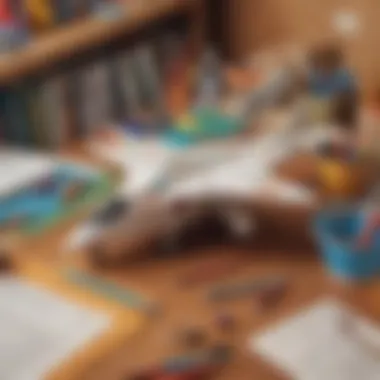

The wing shape and angle are fundamental characteristics that dictate how a paper airplane interacts with air. Wider wings can provide more lift, helping the airplane to stay airborne longer. This makes such designs popular among creators looking to achieve lofty flight times. On the other hand, narrow wings can decrease drag, promoting speed during travel.
The unique feature of wing shape and angle lies in their versatility. By simply altering the angle of the wings, one can achieve different flight paths. However, adjusting this can come with trade-offs. Too much angle could lead to stalling, while too little might result in rapid descent. Understanding these dynamics empowers creators to make informed design choices.
Data Collection and Analysis
Data collection and analysis involve observing how different modifications impact flight performance. Keeping track of various flights helps in identifying patterns and optimizing designs. This can include measuring flight distances and times after each modification. For instance, logging distances flown, weight adjustments, and changes in wing structure allows for a more scientific approach to design.
Engaging in this analytical process not only reinforces scientific principles but also enhances critical thinking skills. Paper airplane enthusiasts can learn how to interpret data, make predictions, and validate their results based on test outcomes. Through this iterative approach, both children and their mentors gain hands-on experience in the art and science of flight.
Fostering Creativity Through Paper Airplane Folding
The process of folding paper airplanes serves as a simple yet profound way to cultivate creativity in children and adults alike. This activity extends beyond the act of making something to fly; it engages the mind in a hands-on exploration of ideas, techniques, and innovations. Creative thinking, encapsulated in the DIY nature of paper airplane crafting, can yield numerous benefits. For those facilitating this activity—parents, teachers, or mentors—it presents an opportunity to connect instructions and concepts with creativity.
Encouraging Experimentation
Children often learn best through trial and error, and paper airplane folding provides an ideal platform for this. When a child folds a new design or alters an existing one, they embark on a journey of experimentation. Simple variations, such as adjusting the wing size or changing the nose shape, can dramatically affect performance. This trial-and-error method encourages kids to ask questions and find solutions independently. It helps them understand that failure is not the end, but a necessary step towards success.
- Encouraging experimentation can be as simple as:
- Allowing children to modify original designs.
- Discussing what makes a plane fly well versus poorly.
- Promoting discussions on results after test flights.
Incorporating Art into Aerodynamics
Integrating art into the folding process not only enhances visual appeal but also helps in teaching foundational concepts of aerodynamics. By allowing children to express themselves through color and design, this process transforms basic aircraft models into personal masterpieces.
This nexus of art and science opens the door to diverse learning opportunities, such as:
- Understanding the balance between aesthetics and functionality.
- Exploring color theory and its potential effects on focus and attention.
- Discussions on how different designs can serve practical purposes.
Artistic elements encourage kids to take ownership of their creations, making the activity more engaging. They learn that practicality does not diminish creativity; rather, it can enhance it. To conclude, fostering creativity through paper airplane folding allows for a multifaceted learning experience, integrating scientific principles with artistic endeavors. It empowers kids to innovate and explore while laying the foundation for critical thinking and problem-solving skills.
Educational Benefits of Paper Airplane Activities
Engaging in the activity of folding paper airplanes presents a unique opportunity to harness learning in a playful environment. Paper airplane activities not only delight children, but they also serve as effective educational tools that foster vital skills. This section explores the significance of these benefits in a hands-on learning experience.
STEM Learning Opportunities
STEM, which stands for Science, Technology, Engineering, and Mathematics, is an essential framework in modern education. Paper airplane folding is an excellent way to introduce children to these subjects. As they fold and modify their designs, they begin to understand fundamental principles of physics, such as aerodynamics and force dynamics.
When children construct planes, they engage in practical problem-solving. They can test various wing shapes and sizes, running basic experiments to observe their effects on flight distance and stability. Through these creations, kids become mini-engineers, applying their knowledge in real-time. Moreover, discussions around design can lead to an exploration of technology in aerospace engineering, enhancing their understanding of practical applications.
Additionally, educators can integrate mathematics into these activities by calculating distance, speed, or even conducting data analysis on flight times. Creating graphs or visual representations based on their outcomes is another excellent engagement. Therefore, folding paper airplanes serves as a valuable entry point into STEM, marrying fun with educational rigor.
Enhancing Critical Thinking Skills
Folding paper airplanes is not just about creating flying objects; it inherently encourages children to think critically. The process requires observation, analysis, and evaluation. As they fold, they must consider what designs work best, why some planes fly farther than others, and how subtle changes affect performance.
Children encounter various challenges, such as balancing weight or adjusting wing flap angles. To find solutions, they must experiment and adapt their approaches, honing their reasoning skills.
Additionally, they can learn from failure. If a design does not perform as expected, children can reflect on what went wrong, testing hypotheses to understand better. This iterative process fosters resilience and adaptability, attributes that are crucial for success in any discipline.
"Folding paper airplanes creates an exciting learning atmosphere where children can explore scientific principles while developing necessary cognitive skills."
Finale
In concluding our exploration of paper airplane folding, it is crucial to recognize the multifaceted importance of this seemingly simple pastime. This activity is not just about creating a flying object; it serves as a gateway to understanding complex scientific principles. Through engaging with the aerodynamics involved, participants particularly children, can develop a deeper appreciation for physics and engineering concepts in a tangible manner.
Summary of Key Points
As we reflect on the key points made throughout the article, several vital themes emerge:
- Foundation of Aerodynamics: The journey begins with understanding the four forces of flight: lift, drag, thrust, and weight, which influence every paper airplane's flight.
- Design Significance: Each folding technique and design variation yields different aerodynamic benefits, emphasizing the relationship between form and function.
- Creativity Meets Science: The fusion of art and science in paper airplane folding fosters creativity, providing a platform for experimentation and innovation, encouraging learners to boldly explore and adapt designs.
- Educational Benefits: This activity functions as a hands-on learning experience that nurtures critical thinking, problem-solving skills, and promotes interest in STEM (Science, Technology, Engineering, and Mathematics) subjects.
Encouragement for Further Exploration
Finally, as we conclude, it is essential to encourage further exploration beyond the basic folding techniques. The world of paper airplanes offers endless possibilities.
- Experiment with Materials: Try various paper types or even experiment with materials that are generally not used in airplane construction, like cardboard or foil, to understand how they impact flight performance.
- Enhance Designs: Challenge yourself to alter dimensions and wing shapes, discover how these modifications can enhance performance, or create unique designs that reflect personal style.
- Share Findings: Join online communities like reddit.com or engage with local clubs to share your designs and findings. Observing how different approaches yield various outcomes can be invaluable for learning.
"The beauty of paper airplanes lies in their simplicity and the depth of knowledge they can impart."
By inviting further experimentation and sharing knowledge, we contribute to an ongoing cycle of learning and creativity in the field of aerodynamics.







